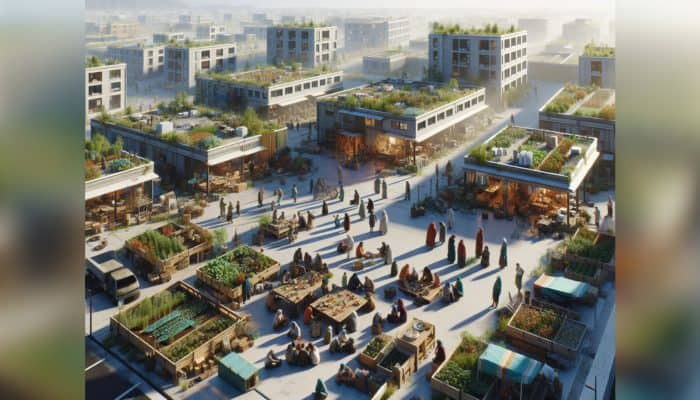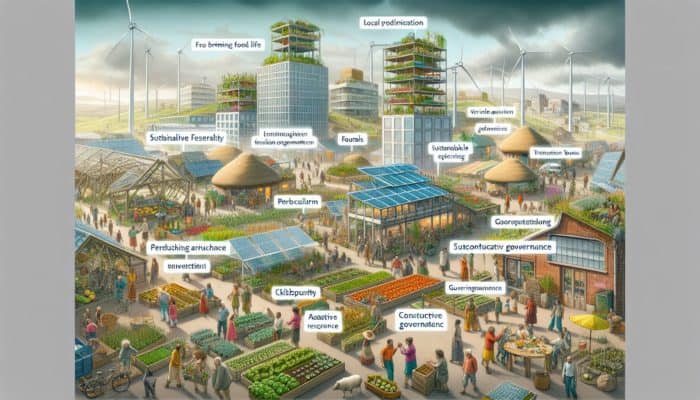Building Strong Foundations for Post-Collapse Communities
Understanding Resilience in Post-Collapse Environments

Post-Collapse Community: Resilience within post-collapse environments is fundamentally rooted in a community’s capacity to adapt, recover, and flourish amid considerable adversities. It transcends mere survival; it encompasses the nurturing of the social, economic, and environmental frameworks that bind a community. Robust social connections foster collaboration, enabling individuals to share resources and offer emotional support. On the economic front, resilience requires diversification of income streams to reduce reliance on external market fluctuations, thereby empowering communities to sustain themselves independently. Environmentally, resilient communities adopt sustainable practices that conserve resources for future generations. Exemplary cases can be observed globally, from urban agricultural initiatives in Detroit to traditional farming techniques in rural India, demonstrating a harmonious blend of innovation and cultural heritage.
Essential Components of a Sustainable Community After Collapse
A sustainable community emerging from a collapse is underpinned by several key elements that ensure its durability and self-sufficiency. Food security is paramount; communities must secure access to local food supplies, which can be achieved through community gardens and urban farms that maximize vertical space in metropolitan areas, or through traditional agriculture in rural regions. Energy independence plays a crucial role, where harnessing renewable energy sources such as solar, wind, and hydroelectric power diminishes reliance on external energy providers. Governance structures should be inclusive and transparent, giving every community member a voice, thereby enhancing social trust and cohesion. Successful implementations of these principles can be observed in eco-villages across Europe and permaculture communities in Australia, where holistic strategies have led to sustainable lifestyles.
What Are the Initial Steps to Establishing a Post-Collapse Community?
The journey towards establishing a resilient post-collapse community begins with effective community engagement. This critical first step involves convening community members to articulate their needs, values, and visions for the future. Assessing available resources is equally essential; communities must compile an inventory of their skills, tools, and materials to identify both strengths and weaknesses. Subsequently, creating a communication plan that promotes ongoing dialogue and collaboration among members is vital. Initiatives such as skill-sharing workshops and community meetings can establish a solid foundation for cooperation. Lastly, it is imperative to prioritise immediate needs, such as food, water, and shelter, ensuring that the community can meet its basic survival requirements before progressing towards long-term objectives, as demonstrated by neighbourhood recovery efforts following natural disasters.
Insights from Experts on Post-Collapse Community Resilience

How Can Experts Enhance Community Resilience?
Experts play an indispensable role in bolstering community resilience by offering specialised knowledge and guidance. Their involvement typically commences with comprehensive assessments that identify risks and vulnerabilities within the community, which helps to prioritise recovery actions. For instance, urban planners can design layouts that foster social interaction and resource sharing, while agricultural specialists can implement sustainable farming practices tailored to the local context. Notable case studies, such as the Post-Disaster Needs Assessment implemented in Haiti following the earthquake, exemplify how interdisciplinary collaboration among experts enables communities to rebuild more effectively. Furthermore, healthcare professionals can initiate local health initiatives, ensuring that the mental and physical health needs of community members are met, thereby safeguarding the overall well-being of the community.
What Are the Best Practices for Effective Community Planning?
Efficient community planning in a post-collapse scenario necessitates a strategic approach that prioritises adaptability and inclusivity. One of the best practices is to involve community members actively in the planning process, ensuring that their perspectives shape decision-making. This engagement can be facilitated through participatory workshops and surveys, which help cultivate a sense of ownership among residents. Flexibility in planning is crucial, enabling communities to respond to dynamic circumstances, such as changes in available resources or shifts in demographics. Establishing multi-functional spaces that serve various purposes—such as community centres that host markets, workshops, and social gatherings—enhances the utility of shared resources. Lastly, establishing clear governance structures that promote transparency and accountability is crucial for fostering trust and ensuring seamless community operations.
What Successful Models of Post-Collapse Communities Can Be Analyzed?

Examining successful post-collapse community models provides invaluable insights into resilience and sustainability. One prominent example is the Transition Town movement, which originated in Totnes, England, focusing on localising economies and fostering self-sufficiency. This paradigm emphasises community engagement in food production, energy generation, and sustainable practices. Another noteworthy model is the Kibbutz system in Israel, where communal living and shared resources have bolstered resilience through economic cooperation and social support. A thorough analysis of these models reveals recurring themes: strong social ties, effective utilisation of local resources, and adaptive governance structures. Communities can draw lessons from these examples to devise tailored solutions that address their unique challenges and opportunities.
How Can Communities Utilise Expert Knowledge for Long-Term Sustainability?
Communities can successfully leverage expert knowledge by forming partnerships with professionals across various fields, providing ongoing support and resources to enhance their capabilities. This collaboration may take the form of mentorship programmes, where experts impart training and transfer knowledge to community members, thereby enhancing local skills and capacity. Continuous education and workshops on sustainable practices—ranging from agricultural techniques to energy conservation—empower residents to adopt innovative solutions that benefit the environment. Furthermore, communities can establish advisory boards composed of local experts who guide development plans and policies, ensuring alignment with best practices and local needs. By integrating expert insights into community initiatives, not only is resilience fostered, but a culture of learning and adaptability is cultivated, which is fundamental for long-term sustainability.
Economic Strategies for Resilient Post-Collapse Communities
What Economic Systems Are Most Effective After a Collapse?
Post-collapse communities can explore various economic systems that promote sustainability and resilience. Among the first to emerge are barter systems, which enable residents to trade goods and services directly, thus allowing local economies to flourish without reliance on traditional currency. Key advantages of barter systems include:
- Encouragement of local production and consumption
- Reduction of dependence on external financial systems
- Enhancement of community relationships through direct exchanges
- Provision of immediate solutions to resource scarcity
Cooperative economies present another effective model. In these systems, community members collectively own businesses, share profits, and make decisions democratically. Benefits of cooperative economies include:
- Shared financial risk among community members
- Increased job security and local employment opportunities
- Empowerment through collective decision-making
- Enhanced resilience through diversified income sources
Both of these systems offer viable pathways to economic stability, empowering communities to rebuild and prosper despite external challenges.
How Can Local Economies Be Built in Post-Collapse Scenarios?
Establishing local economies in post-collapse scenarios necessitates a commitment to self-sufficiency and effective resource use. Skills development is central to this initiative; communities must identify and cultivate the skills possessed by residents and determine how these can be harnessed to address local needs. This may involve training programmes across various trades, including carpentry, agriculture, or renewable energy installation. Encouraging local entrepreneurship inspires individuals to launch small businesses that meet community demands, thereby creating jobs and stimulating economic growth. Establishing local markets can facilitate the exchange of goods and services, reinforcing economic ties within the community. By effectively utilising local resources—whether through sustainable farming practices or artisan crafts—communities can remain resilient and vibrant in the face of adversity.
How Can Communities Ensure Financial Resilience Following a Collapse?
To maintain financial resilience in a post-collapse setting, communities can adopt several strategic measures. Creating alternative currencies can serve as a practical solution, enabling local exchanges that do not rely on conventional cash systems. This could involve utilising time banks, where services are exchanged based on the time invested rather than monetary value. Another approach is to establish community savings programmes that encourage collective saving, fostering a sense of security and stability among residents. Developing financial literacy programmes is essential; educating community members about budgeting, investment, and resource management ensures informed decision-making. Additionally, forming partnerships with microfinance institutions can provide access to small loans and financial support when necessary, enabling communities to sustain their livelihoods even during challenging periods.
Nurturing Social Structures in Post-Collapse Communities
How Can Social Cohesion Be Fostered in Difficult Times?
Establishing and nurturing social cohesion within a post-collapse community is crucial for long-term resilience. Strong social networks are cultivated through open communication and shared experiences, which empower residents to support one another effectively. Initiatives such as community gatherings, shared meals, or collaborative projects can foster a sense of belonging and mutual aid. Furthermore, creating support networks—particularly for vulnerable populations such as older people or families with young children—ensures that all individuals feel included and valued. Encouraging inclusive decision-making processes, where every voice is acknowledged, cultivates trust and collaboration, reinforcing the community’s social fabric. Successful neighbourhoods that have navigated crises exemplify the importance of unity in overcoming adversity.
How Can Communities Uphold Law and Order After a Collapse?
Establishing and maintaining law and order in a post-collapse context necessitates innovative approaches tailored to the specific community. Community policing can empower residents to actively participate in maintaining safety, fostering trust between law enforcement and citizens. This participatory model encourages collaboration, where community members work alongside local authorities to address issues constructively. Additionally, implementing restorative justice practices can supplant punitive systems, focusing on healing and reconciliation rather than punishment. This approach fosters understanding and accountability, allowing communities to resolve conflicts constructively. Developing a clear set of community guidelines and norms ensures that all members are aware of expectations, facilitating peaceful coexistence even amid challenging circumstances.
What Is the Role of Education in Building Post-Collapse Communities?
Education is fundamentally important in promoting resilience and adaptability within a post-collapse community. It equips residents with the knowledge and skills necessary to navigate challenges effectively. Formal education can be complemented by informal learning opportunities, such as workshops, community discussions, or skill-sharing sessions, all of which encourage lifelong learning. Topics may encompass sustainable agriculture, conflict resolution, or financial literacy—elements essential for constructing a self-sufficient community. Moreover, integrating local culture and history into educational curricula fosters a sense of identity and pride among residents, thereby promoting unity and a shared purpose. Communities that prioritise education lay a solid foundation for resilience, ensuring that members are equipped to thrive in an uncertain future.
Research-Driven Advantages of Post-Collapse Communities
What Psychological Benefits Are Associated with Community Resilience?
Living within a resilient community following a collapse provides significant psychological benefits, as strong social connections can dramatically alleviate stress and anxiety. Residents who feel supported are better equipped to confront challenges and uncertainties, which fosters a sense of belonging that enhances their overall well-being. Community involvement cultivates a shared identity, instilling purpose and motivation in collective recovery efforts. Furthermore, access to shared resources and social support networks can alleviate feelings of isolation that often accompany crises. Participation in communal activities also provides opportunities for emotional expression and healing, thereby reinforcing the bonds that contribute to mental health and leading to a more cohesive and resilient community.
How Does Community Resilience Influence Physical Health?
The relationship between community resilience and physical health is profound, as resilient communities typically provide improved access to essential resources and services. Access to local food sources ensures that residents can maintain a nutritious diet, directly impacting their physical well-being. Additionally, communities that promote social cohesion and support networks facilitate healthier lifestyles, as individuals are more likely to partake in physical activities and share health-related information. Local healthcare initiatives can target community-specific health requirements, advocating for preventative care and education. Various studies have shown that the physical health of residents often improves through interconnectedness and shared resources within resilient communities, highlighting the critical role social structures play in overall health.
What Environmental Advantages Do Resilient Communities Offer?
Establishing resilient communities brings significant ecological benefits, as they often prioritise sustainable resource management and environmental stewardship. Communities that adopt practices such as permaculture, reforestation, or community gardening have a positive impact on local ecosystems, promoting biodiversity and enhancing soil health. By focusing on sustainable energy solutions, such as solar panels or wind turbines, these communities can reduce their environmental footprint and dependency on fossil fuels. Additionally, resilient communities are more inclined to embrace circular economies, minimising waste and encouraging material reuse. The integration of these practices not only fosters ecological balance but also enhances the community’s long-term sustainability and health, creating a harmonious relationship with the environment.
What Economic Advantages Do Resilient Communities Provide?
Resilient communities can drive economic stability and growth through strategic approaches to resource utilisation. By focusing on local production and consumption, these communities can reduce their dependence on external markets, thereby fostering self-sufficiency. Cooperative business models enable residents to pool resources and share risks, bolstering their economic resilience. Moreover, community-driven initiatives frequently yield innovation, as residents collaborate to develop solutions tailored to their specific needs. The economic advantages extend beyond mere survival, as resilient communities can generate employment, boost local commerce, and attract investment by showcasing their adaptability and resourcefulness. As communities grow more self-reliant, they pave the way for sustainable economic growth that benefits all residents.
Innovative Technologies for Post-Collapse Communities
Implementing Renewable Energy Solutions for Sustainability
The adoption of renewable energy solutions is a pivotal strategy for post-collapse communities seeking sustainability and resilience. By harnessing sources such as solar, wind, and hydro power, communities can significantly reduce their reliance on non-renewable energy sources while enhancing energy independence. For instance, installing solar panels on community buildings facilitates localised energy generation, substantially lowering electricity costs. Wind turbines can further supplement this by effectively harnessing natural resources, particularly in areas with consistent wind patterns. Additionally, communities can explore micro-hydro systems, especially in regions near flowing water, to sustainably generate electricity. By prioritising these energy solutions, communities can cultivate long-term resilience and adaptability while minimising their environmental impact.
How Can Technology Support Communication in Post-Collapse Communities?
Technology plays a crucial role in maintaining communication networks within communities following a disaster or collapse. Low-tech solutions, such as community bulletin boards or radio broadcasts, can effectively facilitate the dissemination of information, particularly in areas where internet access is limited. High-tech options, including mobile applications or social media platforms, can enhance connectivity, enabling residents to organise and communicate quickly. For example, dedicated apps can provide updates on community resources, emergency alerts, or collaborative projects. Establishing a comprehensive communication strategy that integrates both low-tech and high-tech solutions ensures that all community members remain informed and engaged, fostering cohesion and resilience in challenging times.
Leveraging Technology for Efficient Resource Management
Effectively utilising technology can optimise resource allocation and management within post-collapse communities. Implementing inventory systems can assist in tracking local resources, ensuring efficient use, and minimising waste. Data analysis tools can yield insights into community needs and resource availability, facilitating informed decision-making regarding distribution and prioritisation. Communities can also adopt platforms that promote sharing, such as tool libraries or communal gardens, encouraging collaborative resource use. Key technologies for effective resource management include:
- Inventory management software for tracking supplies
- Data analytics tools for assessing community needs
- Online platforms for resource and skill sharing
- Mobile apps for coordinating community initiatives
By integrating modern technology into resource management practices, communities can enhance their resilience and operational efficiency, adapting more effectively to the realities of a post-collapse environment.
Utilising Technology for Sustainable Agriculture
Technology plays a significant role in enhancing food production and sustainability within post-collapse communities. Implementing precision farming techniques, which utilise data analysis and technological advancements to optimise crop yields, allows communities to grow food more efficiently while minimising resource consumption. Hydroponics systems represent an innovative solution for producing food in limited spaces, enabling the growth of fresh produce in urban environments or areas with poor soil quality. Additionally, incorporating agricultural drones can help monitor crop health and soil conditions, providing valuable insights that inform management decisions. By leveraging these technologies, communities can enhance food security, minimize their environmental footprint, and cultivate local food systems that promote resilience and sustainability.
Frequently Asked Questions
What Constitutes a Post-Collapse Community?
A post-collapse community is a collective of individuals who unite to rebuild and sustain their lives following a significant disruption, such as natural disasters, economic failures, or societal breakdowns.
How Can Communities Enhance Their Resilience?
Communities can bolster resilience by nurturing robust social connections, diversifying economic systems, and prioritising sustainable resource management practices.
What Is the Role of Education in a Post-Collapse Community?
Education fortifies community resilience by equipping members with critical skills and knowledge, fostering adaptability, and cultivating a culture of continuous learning and improvement.
What Examples Exist of Successful Post-Collapse Communities?
Examples include Transition Towns in the UK, which emphasise localisation, and cooperatives that focus on shared ownership and mutual assistance among members.
How Do Communities Maintain Law and Order After a Collapse?
Communities can uphold law and order through community policing and restorative justice practices, fostering collaboration and emphasising healing rather than punishment.
What Economic Benefits Do Resilient Communities Offer?
Resilient communities can foster economic stability by promoting local production, creating jobs, and promoting self-sufficiency, ultimately leading to sustainable growth.
How Can Technology Improve Communication in Post-Collapse Communities?
Technology can enhance communication through low-tech solutions, such as bulletin boards, and high-tech options, like mobile apps, ensuring residents remain informed and engaged.
What Sustainable Energy Options Are Accessible for Communities?
Communities can explore solar, wind, and hydro energy solutions, which can diminish reliance on non-renewable sources while enhancing energy independence.
How Can Communities Ensure Food Security After a Collapse?
Communities can guarantee food security by adopting local food production methods, such as community gardens, permaculture, and sustainable agricultural practices.
What Psychological Benefits Do Resilient Communities Provide?
Living in resilient communities offers psychological advantages, including reduced stress, a sense of belonging, and increased emotional support, all of which contribute to overall mental well-being.
Discover more with us on X!
Survival Group Trust: Building Strong Bonds
Understanding the Crucial Role of Trust in Survival Groups What Factors Contribute to Building Trust Within a Group? Survival Group Trust: The foundation of any successful survival group. When trust is lacking, group members may struggle to collaborate effectively, severely compromising their chances of success in critical situations. Several key factors contribute to establishing trust […]
Prepper Support Networks: Building Resilient Communities
Understanding the Dynamics of Prepper Support Networks What Exactly Are Prepper Support Networks? Prepper Support Networks: Prepper support networks consist of collaborative communities formed by individuals who prioritise preparedness for a range of emergencies and disasters. These networks focus on teamwork, resource sharing, and knowledge exchange to enhance resilience and promote self-sufficiency during challenging situations. […]
Prepper Teamwork Ideas: Building Strong Communities
Creating High-Performing Prepper Teams for Emergency Preparedness Clearly Defining Team Roles and Responsibilities for Success Prepper Teamwork Ideas: Establishing clear roles within a prepper team is paramount to ensuring that every member understands their specific duties, thereby enhancing overall operational effectiveness. By assigning distinct roles — such as team leader, medic, logistics coordinator, and security officer —the […]
Prepper Unity Strategies: Building Strong Communities
Building Strong Foundations for Unity in Prepper Communities Essential Principles That Foster Community Unity Prepper Unity Strategies: Understanding the fundamental values that promote unity among preppers is vital for creating robust and resilient communities. These core values encompass shared responsibility, mutual support, respect for Diversity, and a commitment to collective goals. When individuals unite under […]







You’ve touched on such an important concept in your post—resilience truly is more than just survival; it’s about thriving in the face of adversity. I appreciate how you highlight the interconnectedness of social, economic, and environmental factors, as these are often underestimated in discussions about community resilience.
This topic resonates deeply with me, especially in light of recent global challenges. I’ve seen firsthand how community resilience can transform to support one another, particularly in times of crisis. For example, during the pandemic, local groups emerged to share resources, from food to skill training, proving that human connection can be the strongest asset in rebuilding and reimagining our societies.
Your observations hit home in a profound way. The pandemic really laid bare how interconnected we all are, didn’t it? It’s remarkable to see how, in moments of vulnerability, communities can rise to the occasion, tapping into local strength to foster resilience and connection.
I completely agree with you; community resilience is such a powerful force, especially when faced with global challenges. Your point about local groups stepping up during the pandemic really highlights how necessity can spark creativity and collaboration. I remember seeing food banks and mutual aid networks pop up all over the place, not just in big cities but in smaller towns too. It was inspiring to witness neighbors looking out for one another, sharing not only resources but also skills and knowledge.